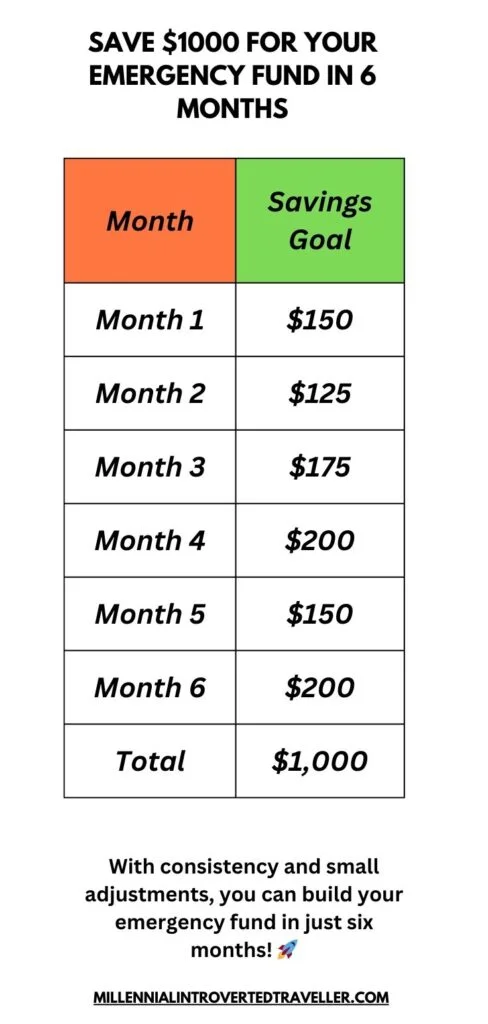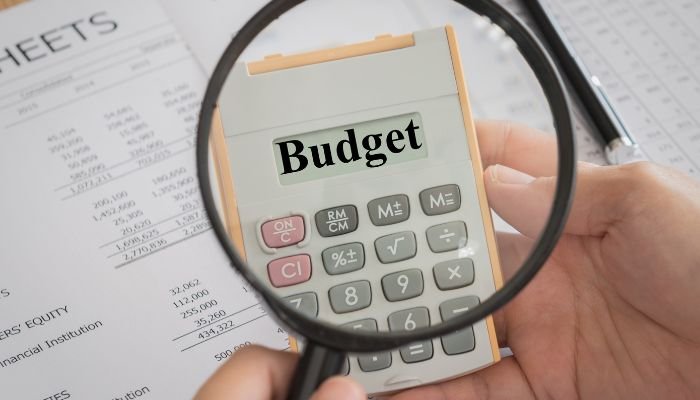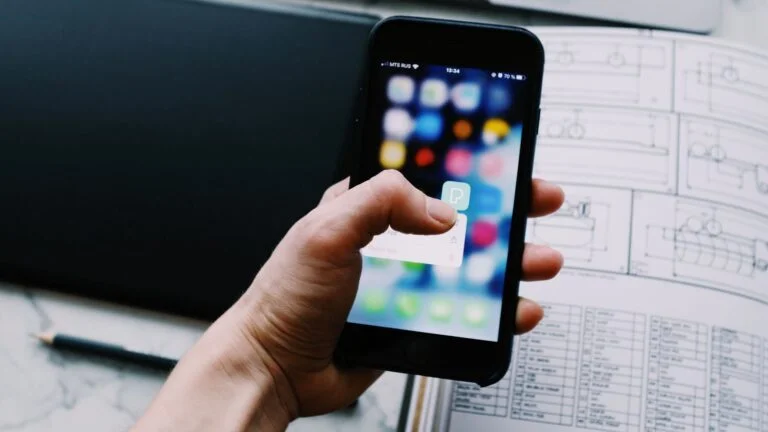Disclaimer: This post may contain affiliate links, meaning we get a small commission if you make a purchase through our link at no extra cost to you. For more information, please visit our Disclaimer Page.
Saving money can feel overwhelming, especially when you’re just starting. But with the right plan, learning how to save $1000 for your emergency fund in 6 months becomes achievable.
It’s all about breaking your goal into smaller steps, cutting unnecessary expenses, and building habits that stick.
A solid emergency fund offers peace of mind, helping you handle unexpected expenses without added stress.
Let’s explore practical tips to help you reach your savings goal quickly and effectively.
It’s important to keep your emergency fund separate. Use a savings or money market account to avoid spending it on non-essentials.
By following these steps, you can save $1000 in 6 months. This is a big step towards securing your financial future.
Understanding the Importance of an Emergency Fund
When it comes to budgeting for emergencies, having a solid plan is key. This is why building an emergency fund fast is so important.
Only 44 per cent of Americans can cover a $1000 expense from savings. This shows the need for a good emergency fund.
To start, knowing what a financial emergency is is vital. It could be car repairs or medical bills. Knowing what you’re saving for keeps you focused.
Saving strategies for emergencies should fit your life, considering your job, expenses, and income.
What Qualifies as a Financial Emergency
Financial emergencies are unpredictable, so having a cushion is essential. Budgeting for emergencies helps you save for unexpected costs.
By saving a part of your income each month, you’re ready for any surprise expenses.
Why $1000 is Your First Milestone
Reaching a $1000 savings goal is a big step. It covers small emergencies and boosts your savings drive.
Dave Ramsey suggests starting with $1000, aiming for 3-6 months of expenses later.
Having a preparedness mindset is key to building emergency savings. It creates a sense of security by combining structured plans with realistic goals.
Building an emergency fund quickly means preparing for life’s surprises—and staying disciplined along the way.
Saving $1,000 in six months for your emergency fund
Set a plan to save $1,000 in six months by breaking it into manageable steps:
- Calculate your target: Use an emergency fund calculator to determine how much to save monthly.
- Track progress: Adjust your strategy if you fall behind.
Ways to reach your goal:
- Reduce unnecessary expenses (e.g., dining out, subscriptions).
- Start a side hustle for extra income.
- Automate savings to ensure consistency.
With discipline and the right tools, saving $1,000 in six months is achievable.
How to build your own emergency fund plan
Begin by auditing your finances:
- Income vs. expenses: List all earnings, bills, debts, and existing savings.
- Set realistic targets: For example, saving 1,000insixmonthsrequiressettingasideroughly1,000insixmonthsrequiressettingasideroughly167 monthly.
Why budgeting matters:
- A budget helps prioritize saving.
- Automate transfers to avoid overspending.
A how-to guide: Building your emergency fund
Aim to save three to six months’ worth of expenses, depending on income, lifestyle, and family size.
Make saving easier:
- Start small: Break large goals into monthly targets (e.g., $50/week).
- Automate savings: Set up recurring transfers to a dedicated account.
- Use windfalls wisely: Redirect tax refunds, bonuses, or gifts to your fund.
- Trim expenses: Cancel unused subscriptions, cook at home, or switch to cheaper services.
Example Plan: Save $1,000 in 6 Months
| Month | Savings Goal |
|---|---|
| Month 1 | $150 |
| Month 2 | $125 |
| Month 3 | $175 |
| Month 4 | $200 |
| Month 5 | $150 |
| Month 6 | $200 |
| Total | $1,000 |
With consistency and small adjustments, you can build your emergency fund in just six months!

The first step to building your emergency fund is finding extra money in your budget.
Step 1: Reduce non-essential spending.
Identify and cut unnecessary expenses (e.g., subscriptions, dining out).
Step 2: Earn more.
Take on a part-time job, freelance gig, or sell unused items.
Step 3: Automate savings.
Set up automatic transfers from your paycheck to a dedicated emergency fund account. This reduces temptation and ensures consistency.
Emergency Savings Tips to Jumpstart Your Fund
- Audit your budget monthly to spot cost-cutting opportunities.
- Follow the 50/30/20 rule: Allocate 50 per cent of income to needs, 30 per cent to wants, and 20 per cent to savings.
- Use an emergency fund calculator to determine your monthly savings target.
Example:
To save 1,000 in six months, aim to set aside 167 monthly.
How to Use an Emergency Fund Calculator
- Input your goal: Start with a realistic target (e.g., $1,000).
- Set a timeline: Choose a manageable period, like six months.
- Track progress: Update the calculator with your current savings to adjust your monthly target.
This tool highlights how increasing savings accelerates your goal.
Pair it with strategies like automating transfers or trimming expenses to stay on track.
Implementing Dave Ramsey’s Emergency Fund Strategy
Dave Ramsey’s Baby Steps provide a roadmap to financial security:
- Save $1,000 for starter emergencies.
- Pay off non-mortgage debt using the debt snowball method.
- Build a 3–6 month emergency fund.
- Invest 15 per cent of income for retirement.
- Save for children’s education.
- Pay off your mortgage early.
- Build wealth and give generously.
This approach prioritizes a $1,000 “baby emergency fund” as a buffer before tackling debt.
Why a $1,000 Emergency Fund Matters
- Cushions small crises: Covers unexpected car repairs or medical bills.
- Reduces debt reliance: Avoids high-interest loans for emergencies.
- Builds momentum: Achieve this first goal to stay motivated for larger financial milestones.
Having built your emergency fund, the next step is to protect it.
Keeping Your Emergency Fund Safe
- Use it only for true emergencies: Car repairs, medical bills, or unavoidable crises—not discretionary expenses.
- Review your budget monthly: Adjust allocations to ensure consistent contributions.
- Boost savings passively: Automate transfers from your paycheck to your emergency account.
Strategies to Maintain Your Fund
- Trim expenses: Cancel unused subscriptions, cook at home, or negotiate bills.
- Increase income: Start a side hustle or sell unused items.
- Automate savings: Set up recurring transfers to your emergency fund.
By prioritizing these steps, you’ll safeguard your financial stability against surprises.
How Much Should You Save?
Financial experts recommend saving three to six months’ worth of expenses. This buffer covers most unexpected costs, from job loss to urgent home repairs.
Start small if needed:
- Aim to save 50–50–100 monthly.
- Grow contributions as your budget allows.
Pro tip: Store your fund in a high-yield savings account to earn higher interest while keeping it accessible.
Why It Matters
- Avoids debt: Prevents reliance on credit cards or loans during crises.
- Reduces stress: Financial security lets you focus on long-term goals.
- Builds resilience: Prepares you for life’s unpredictability without derailing progress.
Final Thoughts
Emergency savings aren’t merely a safety net — they’re a pillar of financial freedom.
They help you feel secure enough to take on the unknowns of life without entirely disrupting your long-term plans.
By remaining disciplined, regularly putting money away and being proactive about your financial future, you’ll secure that you’re ready for anything that life throws at you.
And with that peace of mind built into your underpinnings, you can spend much of your time focused on creating the future you really want.





